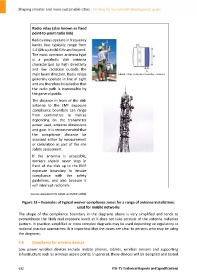Page 622 - Shaping smarter and more sustainable cities - Striving for sustainable development goals
P. 622
Radio relay (also known as fixed
point‐to‐point radio link)
Radio relays operate in frequency
bands that typically range from
1.4 GHz up to 86 GHz and beyond.
The most common antenna type
is a parabolic dish antenna
characterized by high directivity
and low radiation outside the
main beam direction. Radio relays
generally operate in line of sight
and are therefore installed so that
the radio path is inaccessible by
the general public.
The distance in front of the dish
antenna to the EMF exposure
compliance boundary can range
from centimetres to metres
depending on the transmitter
power used, antenna dimensions
and gain. It is recommended that
the compliance distance be
assessed either by measurement
or calculation as part of the site
safety assessment.
If the antenna is accessible,
workers should never step in
front of the dish up to the EMF
exposure boundary to ensure
compliance with the safety
guidelines, and also because it
will interrupt radio link.
Source: Adapted from GSMA and MMF (2008).
Figure 13 – Examples of typical worker compliance zones for a range of antenna installations
used for mobile networks
The shape of the compliance boundary in the diagrams above is very simplified and tends to
overestimate the likely real exposure levels as it does not take account of the antenna radiation
pattern. In practice, simplified or more complex diagrams may be used depending on regulatory or
national practice approaches. It is important that the zones are clear to persons who may be using
the diagrams.
4.6 Compliance for wireless devices
Low power wireless devices include mobile phones, tablets, wireless sensors and supporting
infrastructure such as wireless access points. In general, these devices will be designed and tested
612 ITU‐T's Technical Reports and Specifications

